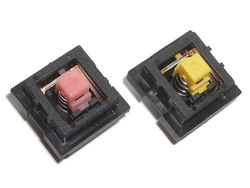RAFI RS 76 M (diode)
| This article requires additional photographic illustration |
 | |
| Manufacturer | RAFI |
|---|---|
| Family | RAFI RS 76 M |
| Introduced | 1975? |
| Switch type | Linear |
| Sense method | Metal contact |
| Rated lifetime | 10M |
| Bounce time | 5 ms |
| Total travel | 4 mm |
| Keycap mount | RAFI mount |
| Switch mount | PCB mount |
In addition to the basic RS 76 M design, RAFI RS 76 M switches have a set of diode variants.
Contents
Design
Unlike most if not every other switch type that supports an internal diode, RS 76 M has only two legs. The stationary contact is attached directly onto one of the diode legs, and the other leg of the diode is used as a terminal.
The diode is therefore non-optional: it is part of the switch mechanism itself. The internals of the switch are quite different to that of the non-diode switch. The base of the switch does not secure the diode: the lid of the switch includes a block that rests on the diode and holds it in place. The movable contact is also not secured by the base, and appears to also be held in place by the lid.
The stationary contact is minute, measuring a mere 1.7 × 2.6 × 0.9 mm.
Variants
The 90 cN IP40 version has a pink slider, while the 140 cN IP40 version has a yellow slider. These types were historically stamped with the last three digits of the part number,[1] but judging by the 2016 samples, this practice is no longer followed the diode version. Besides the colour and the return spring, the pink and yellow versions appear to be identical.
An orange version also existed; this has been found both devoid of any codes,[2] and with unclear codes ("258"?) that appear to indicate only the batch number.[3] These have been described as feeling very similar to the pink switches, and other than the colour, appear not to differ externally from the pink version. Tentative evidence suggests that the orange version is older, but most photographs showing the chips in these keyboards are too small to read the date codes from them.
The pink version has a return spring of 0.27 mm gauge wire and 12.7 mm length. The yellow version has a spring of 11.9 mm length; this has been measured as both 0.29 mm and 0.31 mm gauge wire, from two sample switches supplied together.
Disassembly
Disassembly is very easy, requiring only two steps to separate all parts except the stationary contact:
- Unclip the switch top using one tip of a fine pair of tweezers
- Using fine tweezers, grip the flat, vertical part of the stationary contact and pull it upwards
The stationary contact can be removed by prising it off the diode leg with a sharp knife; significant work will be required to return the diode legs to their original shape afterwards as they are very soft and bend readily. Reattachment of the stationary contact has yet to be attempted.
Reassembly
While disassembly is trivial, reassembly is fiddly, as all that holds the switch mechanism together is the top cover and the very weak friction fit of the movable contact. Failure to keep the slider depressed with your thumb during reassembly can result in the switch flying apart.
- Insert diode; it will be loose fit until the lid is replaced
- Insert return spring
- Place the slider over the return spring and press it down with your thumb (otherwise it will simply fall out)
- Keeping the slider depressed, slide the movable contact over the slider, and lower it into place (this may require tweezers, as it is quite tricky to position it into its slot)
- Gently ease off the pressure on the slider; the movable contact may remain in place, but it may have lost its friction fit during removal and if so it would fly out if the slider were released, along with the slider and return spring
- If the movable contact is in firmly, you can let go of the slider and snap the cover back on; if the movable contact appears that it will come loose, then keep the slider depressed with your thumb while you slide the cover into place, and then snap the cover back on
Keyboards
- NCR Decision Mate V keyboard (orange)[2]
- RAFI KL 003 keypad (pink; possibly 1993)[4]
- RAFI Compudent (pink, yellow; 1992)[1]
- RAFI DT-02 (orange)[3]
Gallery
Pink variant
Yellow variant
References
- ↑ 1.0 1.1 Deskthority — RAFI Compudent Keyboard
- ↑ 2.0 2.1 Deskthority — NCR Decision Mate V Keyboard [conversion]
- ↑ 3.0 3.1 Deskthority — RAFI DT-02 Keyboard
- ↑ Google+ — RAFI KL 003 Keypad Dated 2011-11-12. Retrieved 2015-08-01.


















